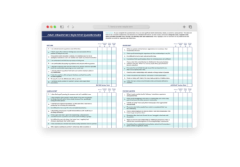Working with anxiety often calls on us to be clinical detectives. Beneath the visible symptoms—worry, fear, physiological arousal—lies a deeper story. In many cases, anxiety is not the core issue, but a messenger pointing toward unprocessed trauma.
When phobias, panic attacks, or social anxiety present in clients—sometimes appearing out of nowhere—it falls to us as clinicians to follow the clues, unraveling years of seemingly unrelated symptoms, contradictory behaviors, and somatic messages.
That’s because trauma often creates temporal disruptions—frozen moments that surface later without warning. These time-stopped experiences, when unprocessed, can lead to what we call encapsulated anxiety.
To effectively address these patterns, we must first understand how and why traumatic experiences get “stuck” in the body—stopping time—and leading to hypervigilance, nervous system overwhelm, and experiences of anxiety.
Share this Article:
Top Picks for You:
- The 5 Core Fears That Will Transform Your Approach to Client Anxiety
- Feeling Overwhelmed? 5 Techniques to Alleviate Stress and Anxiety
- Healing Attachment Trauma Through Internal Family Systems
- Somatic Approaches to Healing Attachment Patterns
- Attachment Under Stress: A Guide to Activated Attachment Patterns
How to Spot the Hidden Trauma Pattern Behind Stuck Anxiety
Understanding Encapsulated Anxiety
Encapsulated anxiety represents a unique phenomenon in trauma response and recognizing the distinction is crucial for effective therapeutic intervention—when we treat the symptom rather than the root cause, our client’s progress tends to falter. Unlike general anxiety that fluctuates with current stressors, encapsulated anxiety stems from dissociative barriers created during overwhelming experiences.
When we face situations that overwhelm our emotional capacity—experiences too intense, too frightening, or too confusing to process in the moment—our psyche protects us through compartmentalization. The overwhelming emotions, sensations, and beliefs from that moment often become sealed off—encapsulated—in what could be understood as an emotional time capsule.
Those familiar with Internal Family Systems (IFS) therapy might recognize parallels between the source of this encapsulated anxiety and what IFS calls “exiled parts.” Both concepts describe aspects of self that become isolated, carrying memories that the system attempts to protect itself from. While IFS provides a comprehensive framework for working with these parts, understanding encapsulated anxiety specifically illuminates the temporal dimension of how trauma fragments our experience.
Much like the exiles, these encapsulated parts remain stuck at the age and moment of trauma, complete with the perceptions, beliefs, physiological responses, and painful emotions experienced during that overwhelming event. Most importantly, they exist outside our normal flow of time, unaware that months, years, or even decades have passed since the original danger.
From within these capsules, alarm signals continue to broadcast whenever something in the present environment resembles aspects of the original trauma—whether it’s a sound, scent, physical sensation, or interpersonal dynamic. The result is anxiety that seems to emerge “out of the blue,” disconnected from our current reality.

Trauma Stops Time
At the moment of trauma, the nervous system becomes overwhelmed and dissociates to protect us. Sheltered from the full experience, this dissociated part doesn’t recognize that time has moved forward—and critically, it never gets to experience the resolution (i.e., the trauma ending and our ongoing survival).
From its perspective, the danger is happening right now, in this moment, creating reactions that may seem disproportionate or unrelated to the “true” present.
This temporal disruption explains several puzzling aspects of trauma-related anxiety:
- Why anxiety can suddenly surface years after a traumatic event
- Why logical reassurance often fails to calm these anxiety responses
- Why the intensity of reaction often seems disproportionate to current triggers
- Why the same person can simultaneously hold adult awareness (“I know I’m safe”) while experiencing overwhelming fear (“but I feel like I’m going to die”)
Understanding this time distortion is key to recognizing when clients are experiencing encapsulated anxiety rather than generalized worry or fear. By learning to identify these signals, we can adapt our therapeutic approach to address not just the anxiety symptoms, but the frozen fragments of experience that generate them.
How Encapsulated Anxiety Manifests in Daily Life
For our clients experiencing encapsulated anxiety, its impact extends far beyond the therapy room. When we follow the clues as clinical detectives, we begin to see distinctive patterns that differentiate this form of anxiety from more general presentations.
Nervous System Dysregulation
Clients with trauma-related anxiety often describe unpredictable cycles of hyperarousal and shutdown. Unlike the constant worry of generalized anxiety, these states tend to appear suddenly and intensely, triggered by specific environmental cues that resemble aspects of past experiences. A client might function normally for days or weeks, then experience overwhelming nervous system activation from an apparently minor trigger—a certain tone of voice, a familiar gesture, or even a time of year.
Hypervigilance and Scanning
Many clients develop intricate systems of hypervigilance to avoid triggering these encapsulated states. They might constantly scan environments for potential triggers, develop elaborate avoidance strategies, or maintain rigid control over their surroundings.
What can make this hypervigilance distinctive is its often unconscious and specific nature. Unlike the broad worry of generalized anxiety (“what if something bad happens?”), this vigilance targets very specific threats (“I have to know where the exits are” or “I can’t have anyone stand behind me”).
The energy cost of maintaining this constant state of alertness often leads to fatigue, irritability, and difficulty concentrating—symptoms that might mistakenly be attributed to depression or attention issues rather than understood as protective mechanisms against reactivating frozen trauma.
Avoidance Behaviors
Perhaps the most visible manifestation of encapsulated anxiety is the development of avoidance behaviors that may appear irrational to others. These might include:
- Refusing to engage in seemingly harmless activities
- Creating elaborate routines to ensure safety
- Restricting movement through certain spaces or at certain times (e.g., avoiding highway driving)
- Developing rigid rules around interpersonal interactions
Unlike the avoidance seen in phobias, these behaviors may have no obvious connection to the apparent trigger, because the connection lies in the hidden, encapsulated trauma. A client might avoid wearing certain colors, listening to specific genres of music, or entering particular types of buildings—behaviors that make perfect sense when understood as protective responses to perceived threat signals from the past.
Relationship Patterns
The relational impact of encapsulated anxiety can be profound. Clients may struggle with seemingly contradictory patterns—seeking reassurance while simultaneously pushing away support, or alternating between anxious attachment and emotional distancing.
These patterns often reflect the specific relational dynamics present at the time of trauma. A client whose trauma occurred in the context of unreliable caregiving might present with intense fears of abandonment alongside difficulty trusting support when it’s offered. These patterns may emerge specifically in relationships that unconsciously mirror aspects of the original trauma context.
Understanding these real-world manifestations helps us recognize when our clients’ anxiety stems not from current threats or general worry, but from fragments of experience frozen in time, still broadcasting alarm signals from the past into the present.

Following the Clues
As noted earlier, encapsulated anxiety often manifests differently from general anxiety disorders—posing another challenge to our detective skills! One crucial element to note is that, because these reactions are coming from parts trapped experiencing the past, they often appear younger than a client’s true age. This might include feeling fearful, out of control, or at a “loss for words,” when the part lacks the vocabulary to explain their experience.
Here are some other key clues that might suggest your client is experiencing encapsulated trauma rather than generalized anxiety:
Somatic Responses:
- Sudden, intense physical reactions triggered by seemingly minor stimuli
- Reports of feeling physically smaller during anxiety episodes
- Specific body areas that hold tension or sensation during triggers.
These specific somatic symptoms often correspond to how the body responded during the original traumatic event. Clients might report something like, “Whenever this happens, I feel this knot right here in my stomach.”
Emotional Patterns:
- Emotions that seem disproportionate to current situations
- Emotional responses that feel “not like me” or “from another time”
- The sense of being “hijacked” by emotional responses that feel beyond voluntary control
Emotions that arise in these states of anxiety may feel less like normal adult worries, and more like childlike fears or vulnerabilities—“I feel scared like I did when I was a kid”
Cognitive Indicators:
- Thoughts during anxiety that reflect beliefs no longer consciously held
- Age-inappropriate thoughts or perceptions during triggered states
- Difficulty applying current knowledge to emotional experiences—“I don’t know how to handle this”
When clients present with clusters of these indicators—particularly disconnection between their intellectual understanding and emotional experience—consider that you may be encountering encapsulated anxiety rather than traditional anxiety patterns.
Of course, it’s possible for these encapsulated states to form in adulthood as well. A client who experienced a traumatic car accident, for example, may have a part frozen right before the point of impact. While the temporal distortions associated with presentations such as this may not be quite as strong, a feeling of stuckness and somatic symptoms are common. This might present as chronic bracing, specific bodily sensations, or strong feelings of anxiety around particular activities or behaviors, even if cognitively the client knows they are now safe.

Why This Matters: Beyond Traditional Treatment
Traditional anxiety treatments often focus on challenging irrational thoughts, developing coping skills, or gradually facing fears. While effective for many anxiety presentations, these approaches frequently fall short when addressing encapsulated trauma.
The reason is fundamental: traditional methods address anxiety from the perspective of current time, while trauma-related anxiety often exists in a different temporal reality altogether. When cognitive therapies encourage challenging catastrophic thoughts, the rational adult part might understand intellectually, yet the encapsulated part continues to experience danger as absolutely real and immediate. This temporal disconnect explains why many clients find that despite years of conventional treatment, certain triggers continue to activate powerful responses that resist change.
Understanding encapsulated anxiety transforms our clinical approach. Rather than focusing solely on symptom management or cognitive restructuring, we recognize our role as guides helping clients bridge different temporal realities within themselves. This shift creates space for compassion rather than frustration, honors the protective function these responses once served, and offers a pathway toward integration rather than mere management.
For both therapists and clients, approaching these frozen aspects with curiosity rather than judgment becomes essential. Somatic awareness practices, trauma-informed care, and compassionate witnessing create the conditions where encapsulated parts can finally be acknowledged, express their long-held emotions, and—most importantly—recognize that the danger has passed and time has moved forward.
This framework doesn’t just explain persistent symptoms; it offers hope by showing that even long-standing anxiety patterns can transform when we address their true temporal source.





Ready to Begin Your Healing Journey?
Browse on-demand courses and begin learning from top experts today!


